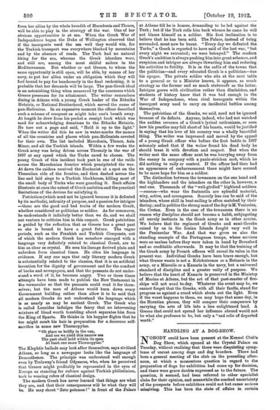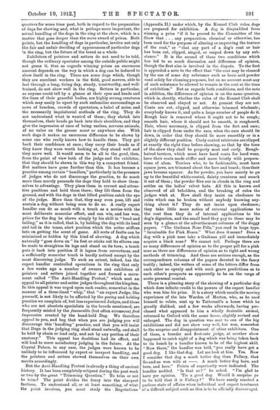HANDLING AT A DOG-SHOW.
NOBODY could have been present at the Kennel Club's Dog Show, which opened at the Crystal Palace on Tuesday, without realizing that there were disquieting symp- toms of unrest among dogs and dog breeders. There had been a general meeting of the club on the preceding after- noon, at which a momentous question in regard to the preparation of dogs for exhibition had come up for decision, and there were grave doubts expressed as to the future. The question, it seemed, had been referred to other specialist clubs for their opinion, and meanwhile the marked uncertainty of the prospects before exhibitors could not but cause serious misgiving. This has been the state of affairs in certain
quarters for some time past, both in regard to the preparation of dogs for showing and, what is perhaps more important, the actual handling of the dogs in the ring at the show, which is a matter that goes deeper than the mere award of prizes. Both points, but the handling of dogs in particular, involve not only the fair and unfair deciding of appearances of particular dogs 'n the ring, but the future of the breed as a whole.
Exhibitors of pointers and setters do not need to be told, though the ordinary spectator among the outside public might not guess it, that as regards winning prizes an enormous amount depends on the way in which a dog can be induced to show itself in the ring. There are some dogs which, though they are excellent workers in the field, good movers, able to last through a long, tiring day, steady, trustworthy, and well- trained, do not show well in the ring. Setters in particular, as anyone could tell by a glance at their eyes and heads and the lines of their graceful bodies, are highly strung creatures which may easily be upset by such unfamiliar surroundings as rows of benches, crowds of spectators, a babel of noise, and the necessarily inquisitorial methods of the ring. They do not understand what is wanted of them ; they shrink into themselves, their heads go back into their shoulders, and they give the impression at once of being useless, nervous animals, of no value on the grouse moor or anywhere else. With such dogs it makes an enormous difference to be shown by some one who really knows how to handle them. They get back their confidence at once ; they carry their heads as if they knew they were worth looking at, they stand well and they move well. It would seem to be all to the good, then, from the point of view both of the judge and the exhibitor, that they should be shown in this way by a competent friend. But matters have gone further than this. It has become a practice among certain " handlers," particularly in the presence of judges who do not discourage the practice, to do much more than merely persuade the dogs they hold to show them- selves to advantage. They place them in correct and attrac- tive positions and hold them there ; they lift them from the ground, and with the dogs in that lifted position catch the eye of the judge. More than that, they may even pose, lift and sustain a dog without being seen to do so. A really expert handler can do as much with a touch as a novice with the most deliberate muscular effort, and can win, and has won, prizes for the dog be shows simply by his skill in " head and tailing," as it is called, that is, by holding the dog with its head and tail in the tense, alert position which the setter stiffens into on getting the scent of game. All sorts of faults can be minimized or hidden by this kind of showing. A dog which naturally "goes down on" its feet or sticks out its elbows can be made to straighten its legs and stand on its toes ; a touch puts it back into position if it lapses from correctness, and a sufficiently muscular touch is hardly noticed except by the most discerning judge. To such an extent, indeed, has the expert handler controlled operations in the ring that only a few weeks ago a number of owners and exhibitors of pointers and setters joined together and formed a move- ment called " The Anti-Handling Protest," which sent an appeal to all pointer and setter judges throughout the kingdom. In this appeal it was urged upon each reader, somewhat in the manner of a three-lined "whip," that "an expert Judge, like yourself, is not likely to be affected by the posing and holding practice we complain of, but less experienced Judges, and those who are not absolute specialists in the breeds mentioned, are frequently misled by the favourable (but often erroneous) first impression created by the hand-held Dog. We therefore appeal to you, and beg that when you are judging you will discourage this `handling' practice, and that you will insist that Dogs in the judging ring shall stand naturally, and shall be held by chain or lead only, and not by any portion of their anatomy." This appeal has doubtless had its effect, and will lead to more satisfactory judging in the future. At the Crystal Palace, in any case, the judges were known to be unlikely to be influenced by expert or inexpert handling, and the pointers and setters showed themselves on their own merits accordingly.
But the Anti-Handling Protest is already a thing of ancient history. It has been completely eclipsed during the past week or two by the great " Trimming Question." To trim or not to trim ? The point divides the fancy into the sharpest factions. To understand all, or at least something, of what the point involves, you must study the Regulations (Appendix II.) under which, by the Kennel Club rules, doge are prepared for exhibition. A dog is disqualified from winning a prize "if it be proved to the Committee of the Show that . . . any preparation, chemical or otherwise, has been used for the purpose of altering or improving the texture of the coat," or " that any part of a dog's coat or hair has been cut, clipped, singed, or rasped down by any sub- stance." It is the second of these two conditions which has led to so much discussion and difference of opinion, though the first also is involved in the dispute. To the first is appended a note to the effect that "the coat may be cleaned by the use of some dry substance such as boric acid powder used solely for cleaning purposes, but on no account must any of such substance be allowed to remain in the coat at the time of exhibition." But as regards both conditions, and the note in addition, the difference of opinion is on the same question, which is, shortly, whether the rules of the Kennel Club shall be observed and obeyed or not. At present they are not. Coats are cut, clipped, and otherwise trimmed wholesale; everybody knows it, and quite a large number of people do it. Rough hair is removed where it ought not to be rough; smooth hair, where it should not be smooth, is roughened. Hair, where necessary, is clipped from the feet and ears; hair is clipped from under the ears, when the ears should lie down, in order that they should lie more smoothly or in a slightly different position. Curly-coated retrievers are clipped at exactly the right time before showing, so that by the time of the show they shall be properly neat and curly. Rough- haired terriers, which must have hard coats for hard wear, have their coats made stiffer and more bristly with prepara- tions of alum. Terriers who, to be fashionable, must have square jaws, are trimmed about the face and beard ; thus their jaws become squarer. As for powder, you have merely to go up to the beautiful white-coated, dainty creatures and smack it out of them ; the powder flies out in clouds in the ring and settles on the ladies' velvet hats. All this is known and observed of all beholders, and the breaking of rules the judges wink at. How shall they insist on obedience to rules which can be broken without anybody knowing any- thing about it ? They do not insist upon obedience; they take little more notice of external applications to the coat than they do of internal applications to the dog's digestion, and the small heed they pay to these may be seen by a glance at the advertisement columns of the doggy papers. " The Gniknan Nose Pills," you read in large type. " Invaluable for Pink Noses." What does it mean P Does a dog with a pink nose take a Gniknan pill and immediately acquire a black nose ? We cannot tell. Perhaps there are as many differences of opinion as to the proper pill for a pink nose as there are differences of opinion as to right and wrong methods of trimming. And these are serious enough, as the correspondence columns of the papers devoted to the fancy testify ; indeed, the writers of some of the letters differ from each other so openly and with such grave predictions as to each other's prospects as apparently to be on the verge of acute personal combat.
There is a pleasing story of the showing of a particular dog which does infinite credit to the powers of the expert handler who won him his prize. It is a story which recalls the moving experience of the late Warden of Merton, who, as he used himself to relate, sent up to Tattersall's a horse which he greatly disliked, and a few weeks afterwards, having pur- chased what appeared to him a wholly desirable animal, returned to Oxford with the same horse, slightly revised and enlarged. The dog in question was sent 'to one of the big exhibitions and did not show very well, but won, somewhat to the surprise and disappointment of other exhibitors. One of these, a breeder and first-rate judge, at another show happened to catch eight of a dog which was being taken back to its bench by a handler known to be of the highest skill. " Now there," the handler was told, " you really have got a good dog. I like that dog. Let me look at him. Yes. Now I consider that dog a much better dog than Fallacy, that So-and-so won with at A much better dog here, and here, and here." Points of superiority were indicated. The handler nodded. "Is that so ? " he asked. " I'm glad to have yer opinion. 'Tis a good dog. Would it surprise ye to be told that it is Fallacy ? " We have surely reached a parlous state of affairs when individual and expert treatment of a difficult subject such as this is to be officially discouraged.















































 Previous page
Previous page